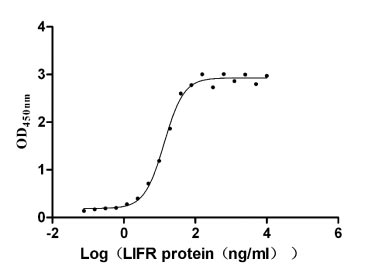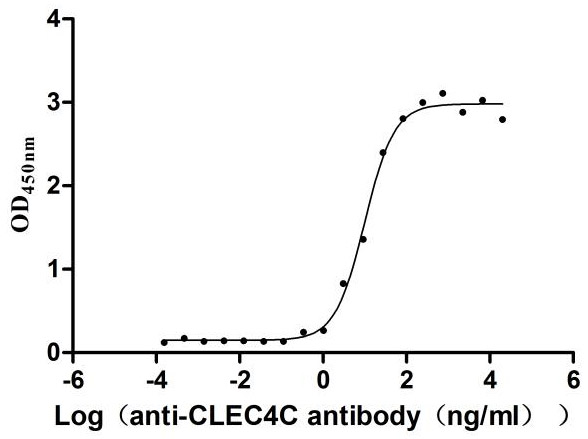Recombinant Human DNA polymerase lambda (POLL)
-
中文名稱:人POLL重組蛋白
-
貨號(hào):CSB-YP871513HU
-
規(guī)格:
-
來源:Yeast
-
其他:
-
中文名稱:人POLL重組蛋白
-
貨號(hào):CSB-EP871513HU
-
規(guī)格:
-
來源:E.coli
-
其他:
-
中文名稱:人POLL重組蛋白
-
貨號(hào):CSB-EP871513HU-B
-
規(guī)格:
-
來源:E.coli
-
共軛:Avi-tag Biotinylated
E. coli biotin ligase (BirA) is highly specific in covalently attaching biotin to the 15 amino acid AviTag peptide. This recombinant protein was biotinylated in vivo by AviTag-BirA technology, which method is BriA catalyzes amide linkage between the biotin and the specific lysine of the AviTag.
-
其他:
-
中文名稱:人POLL重組蛋白
-
貨號(hào):CSB-BP871513HU
-
規(guī)格:
-
來源:Baculovirus
-
其他:
-
中文名稱:人POLL重組蛋白
-
貨號(hào):CSB-MP871513HU
-
規(guī)格:
-
來源:Mammalian cell
-
其他:
產(chǎn)品詳情
-
純度:>85% (SDS-PAGE)
-
基因名:
-
Uniprot No.:
-
別名:BETA N; BETAN; DNA directed DNA polymerase lambda; DNA polymerase beta 2; DNA polymerase beta-2; DNA polymerase kappa; DNA polymerase kappa DNA polymerase beta N; DNA polymerase lambda; DNA polymerase lamda2; DPOLL_HUMAN; EC 2.7.7.7,EC 4.2.99.; FLJ46002; OTTHUMP00000020321; OTTHUMP00000020323; OTTHUMP00000059179; Pol beta2; POL KAPPA; Pol Lambda; POLKAPPA; POLL; Polymerase DNA directed lambda
-
種屬:Homo sapiens (Human)
-
蛋白長(zhǎng)度:full length protein
-
表達(dá)區(qū)域:1-575
-
氨基酸序列MDPRGILKAF PKRQKIHADA SSKVLAKIPR REEGEEAEEW LSSLRAHVVR TGIGRARAEL FEKQIVQHGG QLCPAQGPGV THIVVDEGMD YERALRLLRL PQLPPGAQLV KSAWLSLCLQ ERRLVDVAGF SIFIPSRYLD HPQPSKAEQD ASIPPGTHEA LLQTALSPPP PPTRPVSPPQ KAKEAPNTQA QPISDDEASD GEETQVSAAD LEALISGHYP TSLEGDCEPS PAPAVLDKWV CAQPSSQKAT NHNLHITEKL EVLAKAYSVQ GDKWRALGYA KAINALKSFH KPVTSYQEAC SIPGIGKRMA EKIIEILESG HLRKLDHISE SVPVLELFSN IWGAGTKTAQ MWYQQGFRSL EDIRSQASLT TQQAIGLKHY SDFLERMPRE EATEIEQTVQ KAAQAFNSGL LCVACGSYRR GKATCGDVDV LITHPDGRSH RGIFSRLLDS LRQEGFLTDD LVSQEENGQQ QKYLGVCRLP GPGRRHRRLD IIVVPYSEFA CALLYFTGSA HFNRSMRALA KTKGMSLSEH ALSTAVVRNT HGCKVGPGRV LPTPTEKDVF RLLGLPYREP AERDW
-
蛋白標(biāo)簽:Tag?type?will?be?determined?during?the?manufacturing?process.
The tag type will be determined during production process. If you have specified tag type, please tell us and we will develop the specified tag preferentially. -
產(chǎn)品提供形式:Lyophilized powder
Note: We will preferentially ship the format that we have in stock, however, if you have any special requirement for the format, please remark your requirement when placing the order, we will prepare according to your demand. -
復(fù)溶:We recommend that this vial be briefly centrifuged prior to opening to bring the contents to the bottom. Please reconstitute protein in deionized sterile water to a concentration of 0.1-1.0 mg/mL.We recommend to add 5-50% of glycerol (final concentration) and aliquot for long-term storage at -20℃/-80℃. Our default final concentration of glycerol is 50%. Customers could use it as reference.
-
儲(chǔ)存條件:Store at -20°C/-80°C upon receipt, aliquoting is necessary for mutiple use. Avoid repeated freeze-thaw cycles.
-
保質(zhì)期:The shelf life is related to many factors, storage state, buffer ingredients, storage temperature and the stability of the protein itself.
Generally, the shelf life of liquid form is 6 months at -20°C/-80°C. The shelf life of lyophilized form is 12 months at -20°C/-80°C. -
貨期:Delivery time may differ from different purchasing way or location, please kindly consult your local distributors for specific delivery time.Note: All of our proteins are default shipped with normal blue ice packs, if you request to ship with dry ice, please communicate with us in advance and extra fees will be charged.
-
注意事項(xiàng):Repeated freezing and thawing is not recommended. Store working aliquots at 4°C for up to one week.
-
Datasheet :Please contact us to get it.
相關(guān)產(chǎn)品
靶點(diǎn)詳情
-
功能:DNA polymerase that functions in several pathways of DNA repair. Involved in base excision repair (BER) responsible for repair of lesions that give rise to abasic (AP) sites in DNA. Also contributes to DNA double-strand break repair by non-homologous end joining and homologous recombination. Has both template-dependent and template-independent (terminal transferase) DNA polymerase activities. Has also a 5'-deoxyribose-5-phosphate lyase (dRP lyase) activity.
-
基因功能參考文獻(xiàn):
- Bond formation and cleavage reactions catalyzed by base excision repair DNA polymerases beta and lambda has been described. PMID: 27992186
- When mutated or deregulated, DNA polymerase lambda can also be a source of genetic instability. Its multiple roles in DNA damage tolerance and its ability in promoting tumor progression make it also a possible target for novel anticancer approaches. [review] PMID: 28841305
- Data suggest that individuals who carry the rs3730477 POLL germline variant have an increased risk of estrogen-associated breast cancer. PMID: 27621267
- T204 was identified as a main target for ATM/DNA-PKcs phosphorylation on human POLL, and this phosphorylation may facilitate the repair of a subset of IR-induced DSBs and the efficient POLL-mediated gap-filling during NHEJ. POLL phosphorylation might favor POLL interaction with the DNA-PK complex at DSBs. PMID: 28109743
- The authors demonstrate that Pol lambda has a flexible active site that can tolerate 8-oxo-dG in either the anti- or syn-conformation. Importantly, we show that discrimination against the pro-mutagenic syn-conformation occurs at the extension step and identify the residue responsible for this selectivity. PMID: 27481934
- Pol beta, to a greater extent than Pol lambda can incorporate rNMPs opposite normal bases or 8-oxo-G, and with a different fidelity. Further, the incorporation of rNMPs opposite 8-oxo-G delays repair by DNA glycosylases. PMID: 26917111
- Fen1 significantly stimulated trinucleotide repeats expansion by Pol beta, but not by the related enzyme Pol lambda. PMID: 25687118
- DNA polymerase lamda catalyzes lesion bypass across benzo[a]pyrene-derived DNA adducts. PMID: 25460917
- pol lambda is responsible for a significant fraction of Fapy.dG-induced G --> T mutations. PMID: 25741586
- Structural basis for the binding and incorporation of nucleotide analogs with L-stereochemistry by human DNA polymerase lambda. PMID: 25015085
- A specific N-terminal extension of the 8 kDa domain of DNA polymerase lambda is important for the non-homologous end joining function. PMID: 23935073
- Inactivation of polymerase (DNA directed) lambda lyase activity by 5'-(2-phosphoryl-1,4-dioxobutane prevents the enzyme from conducting polymerization following preincubation of the protein and DNA. PMID: 23330920
- The results provides evidence that DNA pol lambda is required for cell cycle progression and is functionally connected to the S phase DNA damage response machinery in cancer cells. PMID: 23118481
- A structural study shows how a ribonucleotide can be accommodated in the DNA polymerase lambda active site. PMID: 22584622
- Results reveal that DNA pol lambda and DNA ligase I are sufficient to promote efficient microhomology-mediated end-joining repair of broken DNA ends in vitro. PMID: 22373917
- Both Pol lambda- and (Pol kappa)-positive staining were associated with shorter survival in glioma patients. PMID: 20164241
- Pollambda may play a specialized role in the process of repair of these kinds of lesions PMID: 22317757
- Studies indicate that pol lambda undergoes posttranslational modifications during the cell cycle that regulate its stability and possibly its subcellular localization. PMID: 21486570
- In vitro gap-directed translesion DNA synthesis of an abasic site involving human DNA polymerases epsilon, lambda, and beta. PMID: 21757740
- Studies indicate that codon-based models of gene evolution yielded statistical support for the recurrent positive selection of five NHEJ genes during primate evolution: XRCC4, NBS1, Artemis, POLlambda, and CtIP. PMID: 20975951
- study found expression of PollambdaR438W sensitizes cells to camptothecin by affecting the homologous recombination pathway, whereas overexpression of pollambdaWT did not impact cell survival; this effect depends entirely on its DNA polymerase activity PMID: 20693240
- both pol lambda and pol beta interact with the upstream DNA glycosylases for repair of alkylated and oxidized DNA bases PMID: 20805875
- The fidelity of Pol lambda was maintained predominantly by a single residue, R517, which has minor groove interactions with the DNA template. PMID: 20851705
- The results demonstrate that loop 1 is not essential for catalytic activity, but it is important for the fidelity of DNA synthesis and the accuracy of non-homologous end joining. PMID: 20435673
- DNA polymerase lambda can bypass a thymine glycol lesion on the template strand of gapped DNA substrates. PMID: 20423048
- analysis of the interaction between DNA Polymerase lambda and anticancer nucleoside analogs PMID: 20348107
- a natural mutator variant of human DNA polymerase lambda promotes chromosomal instability by compromising NHEJ PMID: 19806195
- DNA polymerase lambda uses a novel sugar selection mechanism to discriminate against ribonucleotides, whereby the ribose 2'-hydroxyl group was excluded mostly by a backbone segment and slightly by the side chain of Y505. PMID: 19900463
- role in DNA repair PMID: 11821417
- role in dna replication and DNA repair PMID: 11974915
- complex between PCNA and pol lambda may play an important role in the bypass of abasic sites in human cells PMID: 12368291
- DNA polymerase lambda has an intrinsic terminal deoxyribonucleotidyl transferase activity that preferentially adds pyrimidines onto 3'OH ends of DNA oligonucleotides and elongates an RNA primer hybridized to a DNA template. PMID: 12683997
- mammalian Pol lambda has a role in non-homologous end-joining PMID: 12829698
- Polymerase lambda is the primary gap-filling polymerase for accurate nonhomologous end joining PMID: 14561766
- pol lambda Phe506Arg/Gly mutants possess very low polymerase and terminal transferase activities as well as greatly reduced abilities for processive DNA synthesis PMID: 14627824
- fills short-patched DNA gaps in base excision repair pathways and participates in mammalian nonhomologous end-joining pathways to repair double-stranded DNA breaks PMID: 15157109
- Results link p53 status with POLkappa expression and suggest that loss of p53 function may in part contribute to the observed POLkappa upregulation in human lung cancers. PMID: 15202001
- A molecular mechanism is suggested for the observed high in vivo rate of frameshift generation by pol lambda and the remarkable ability of pol lambda to promote microhomology pairing between two DNA strands. PMID: 15350147
- A helix-hairpin-helix domain of DNA polymerase lambda is important for primer binding and/or for proliferating cell nuclear antigen interaction. PMID: 15358682
- determined that Fyn phosphorylated MAP-2c on tyrosine 67 PMID: 15537631
- crystal structures of Pol lambda representing three steps in filling a single-nucleotide gap PMID: 15608652
- Human DNA polymerase kappa, an error-prone enzyme that is up-regulated in lung cancers, induces DNA breaks and stimulates DNA exchanges as well as aneuploidy. PMID: 15665310
- Results suggest that Pol lambda plays a role in the short-patch base excision repair rather than contributes to the long-patch base excision repair pathway. PMID: 15979954
- DNA polymerase lambda is phosphorylated in vitro by several cyclin-dependent kinase/cyclin complexes, including Cdk2/cyclin A, in its proline-serine-rich domain. PMID: 16174846
- DNA polymerase lambda has the ability to create base pair mismatches and human replication protein A can suppress this intrinsic in vitro mutator phenotype. PMID: 16522650
- DNA polymerase fidelity is controlled not by an accessory protein or a proofreading exonuclease domain but by an internal regulatory domain PMID: 16675458
- DNA polymerase lambda is unable to differentiate between matched and mismatched termini during the DNA binding step, thus accounting for the relatively high efficiency of mismatch extension. PMID: 16807316
- Kinetic studies on human DNA polymerase lambda reveal roles of a downstream strand and the 5'-terminal moieties PMID: 17005572
- The erroneous nucleotide incorporations catalyzed by DNA polymerases lambda and beta as well as the subsequent ligation catalyzed by a DNA ligase during base excision repair are a threat to genomic integrity. PMID: 17321545
- cloning, expression and tissue distribution in normal liver and hepatoma PMID: 17653665
顯示更多
收起更多
-
亞細(xì)胞定位:Nucleus. Chromosome.
-
蛋白家族:DNA polymerase type-X family
-
組織特異性:Expressed in a number of tissues. Abundant in testis.
-
數(shù)據(jù)庫鏈接:
Most popular with customers
-
Recombinant Human Leukemia inhibitory factor receptor (LIFR), partial (Active)
Express system: Mammalian cell
Species: Homo sapiens (Human)
-
Recombinant Human C-C chemokine receptor type 8 (CCR8)-VLPs (Active)
Express system: Mammalian cell
Species: Homo sapiens (Human)
-
Recombinant Human C-type lectin domain family 4 member C (CLEC4C), partial (Active)
Express system: Mammalian cell
Species: Homo sapiens (Human)
-
Recombinant Human Oncostatin-M (OSM), partial (Active)
Express system: Mammalian cell
Species: Homo sapiens (Human)
-
Recombinant Macaca fascicularis C-type lectin domain family 4 member C(CLEC4C), partial (Active)
Express system: Mammalian cell
Species: Macaca fascicularis (Crab-eating macaque) (Cynomolgus monkey)
-
Recombinant Macaca fascicularis Gastric inhibitory polypeptide receptor (GIPR), partial (Active)
Express system: yeast
Species: Macaca fascicularis (Crab-eating macaque) (Cynomolgus monkey)
-
Recombinant Macaca fascicularis Cadherin 6(CDH6),partial (Active)
Express system: Mammalian cell
Species: Macaca fascicularis (Crab-eating macaque) (Cynomolgus monkey)
-
Recombinant DT3C (Diphtheria toxin & spg 3C domain) for Antibody Internalization Assay (Active)
Express system: E.coli
Species: N/A




















